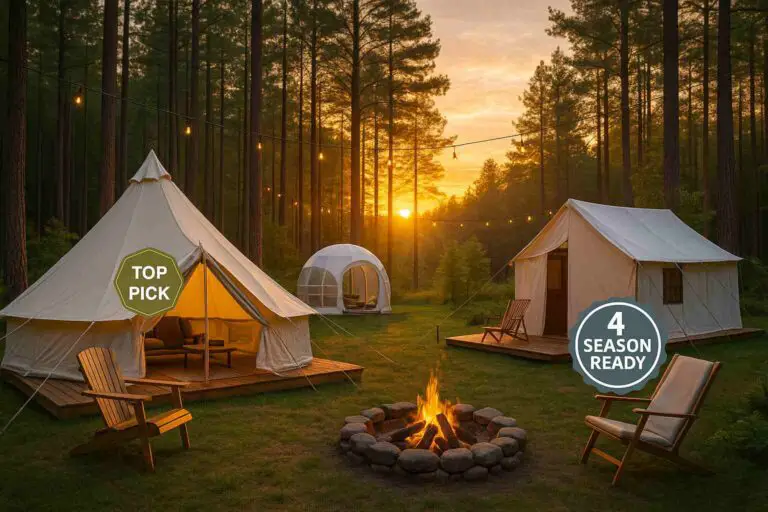Camping is a wonderful outdoor activity that allows us to connect with nature, unwind, and create lasting memories. However, unexpected rain showers can sometimes put a damper on our camping adventures. Being prepared for inclement weather is crucial to ensure a safe and enjoyable experience. In this comprehensive guide, I will explore what to do when it rains while you camping to help you navigate through rainy camping days with ease.
As an avid camper myself, I understand the challenges and frustrations that come with camping in wet conditions. My goal is to provide you with a wealth of knowledge and practical advice that will empower you to face rainy weather head-on while keeping yourself and your gear dry and comfortable. By following the strategies outlined in this article, you’ll be able to turn a rainy camping trip into a memorable and enjoyable experience.
Pre-Trip Preparation
Check the weather forecast: Before embarking on your camping trip, it is essential to check the weather forecast for your destination. Weather conditions can change rapidly, and staying informed will allow you to make necessary adjustments to your plans. Look for reputable weather forecasting sources, such as national meteorological services or reliable online weather websites, to obtain accurate and up-to-date information.
Choose a suitable campsite
When rain is in the forecast, selecting the right campsite becomes even more critical. Consider the terrain and drainage of the area you plan to camp in. Look for elevated or well-drained campsites that are less likely to accumulate water. Avoid areas prone to flooding or with poor drainage, such as valleys or depressions.
Plan your camping equipment and gear
Proper gear selection is key to staying dry and comfortable during rainy camping trips. Ensure you have the following items:
- Waterproof or water-resistant camping gear: Invest in a high-quality waterproof or water-resistant tent that can withstand heavy rain. Look for tents with a rainfly that provides additional protection. Additionally, consider waterproof camping gear such as backpacks, sleeping bags, and footwear to keep your essentials dry.
- Extra tarps, rainfly, and groundsheets: Pack extra tarps or rainfly that can be used to create additional shelter or provide extra coverage for your tent. A groundsheet placed underneath your tent will help prevent moisture from seeping in from the ground.
- Properly waterproofed tent: Before your trip, ensure your tent is properly waterproofed. Seam seal your tent and apply waterproofing spray if needed. This will enhance its ability to repel water and keep you dry inside.
- Appropriate clothing and footwear: Pack waterproof or water-resistant clothing such as rain jackets, pants, and ponchos to protect yourself from the rain. Additionally, bring extra pairs of waterproof or quick-drying socks and sturdy waterproof footwear to keep your feet dry and comfortable.
Setting Up Camp
Selecting an ideal tent location: Choosing the right location for your tent is crucial to prevent water accumulation and ensure a dry and comfortable sleeping area. Follow these tips:
- Look for flat ground away from potential water accumulation: Avoid setting up your tent in low-lying areas or near rivers, streams, or areas with poor drainage. Water tends to collect in these areas, increasing the risk of water entering your tent.
- Consider the natural terrain: Look for areas with natural slopes or elevated ground that can help divert water away from your campsite. If possible, choose a spot with a slight incline to encourage water runoff.
Proper tent setup
To maximize protection against rain, it’s important to set up your tent correctly. Follow these steps:
- Set up the rainfly and secure it tightly: The rainfly is a waterproof cover that goes over your tent and provides an additional layer of protection against rain. Ensure it is properly attached and pulled taut to prevent water from seeping through.
- Use a groundsheet or tarp underneath the tent: Placing a groundsheet or tarp underneath your tent provides an extra barrier against moisture from the ground. Make sure it is slightly smaller than your tent footprint to prevent water from collecting between the groundsheet and the tent floor.
- Consider a footprint or tent footprint: A footprint is a custom-sized groundsheet designed specifically for your tent model. It provides added protection for the tent floor and helps prolong its lifespan. If a footprint is not available, use a tarp or groundsheet that matches the size of your tent.
Creating rain channels and water diversion
Even with proper campsite selection and tent setup, rainwater can still accumulate around your campsite. Implement these techniques to divert water away:
- Digging trenches around the tent: Use a small shovel or your hands to dig shallow trenches around your tent. These trenches will help channel water away from your campsite, minimizing the risk of water pooling near your tent.
- Building channels using natural materials: If digging trenches is not feasible or allowed, you can use natural materials such as branches, leaves, or rocks to create channels that redirect water away from your campsite. Place these materials strategically to guide water flow away from your tent.
Staying Dry and Comfortable
Clothing and personal gear
- Choose quick-drying and moisture-wicking clothing: Opt for clothing made from materials such as polyester or nylon that dry quickly and wick away moisture. Avoid cotton, as it tends to retain moisture and can leave you feeling damp and cold.
- Wear multiple layers: Layering your clothing allows you to adjust your body temperature according to the weather conditions. Start with a moisture-wicking base layer, add insulating layers for warmth, and top it off with a waterproof or water-resistant outer layer to repel rain.
- Utilize rain gear such as waterproof jackets and pants: Invest in high-quality waterproof jackets and pants to shield yourself from the rain. Look for gear with sealed seams or taped zippers for enhanced water resistance.
Managing condensation inside the tent
Rainy weather often leads to increased condensation inside the tent. Follow these tips to minimize moisture buildup:
- Ventilate the tent: Open windows, vents, or mesh panels to improve airflow and reduce condensation. This allows moisture to escape and helps keep the interior drier.
- Use moisture-absorbing materials: Place moisture-absorbing materials like silica gel packs or desiccants inside the tent to help reduce humidity. These packs can be found in stores or online and help absorb excess moisture from the air.
- Avoid cooking inside the tent: Cooking generates moisture and can contribute to condensation. Cook outside the tent or use a separate sheltered area to prevent excessive moisture buildup inside.
Keeping the sleeping area dry
Ensuring a dry and comfortable sleeping area is essential for a good night’s rest. Consider the following tips:
- Use waterproof or moisture-resistant sleeping bags: Invest in sleeping bags specifically designed to withstand wet conditions. These sleeping bags are often made with water-resistant materials and provide better insulation even when damp.
- Place a tarp or groundsheet under sleeping bags: Adding an additional layer of protection between your sleeping bags and the tent floor can prevent moisture from seeping in. Place a tarp or groundsheet underneath your sleeping area to create a barrier against dampness.
- Wipe off excess moisture: Before entering the sleeping area, wipe off any excess moisture from your clothing and gear. This helps minimize the introduction of moisture into your sleeping space.
Rainy Day Activities
Indoor games and entertainment
- Bring board games, cards, or puzzles: Pack a variety of board games, playing cards, or puzzles to keep yourself and your camping companions entertained during rainy days. These classic activities are perfect for bonding and passing the time indoors.
- Engage in storytelling or reading activities: Take advantage of the cozy ambiance inside your tent and engage in storytelling sessions with your camping companions. Alternatively, bring along books or magazines to enjoy some quiet reading time.
Exploring nearby attractions
- Visit local museums, galleries, or indoor tourist spots: Research nearby museums, art galleries, or indoor attractions that you can visit during rainy days. It’s an excellent opportunity to learn about the local culture, history, or art while staying dry.
- Explore nearby towns or cities for shopping or dining options: Take advantage of the rain to explore nearby towns or cities. Browse through local shops, visit quaint cafes, or try out local cuisine to experience the unique flavors of the region.
Embrace the rain
- Go for a hike or walk in the rain (if safe): If the rain is not too heavy and accompanied by thunderstorms or hazardous conditions, consider embracing the rain and going for a hike or a walk. Remember to wear appropriate rain gear and choose trails that are safe and manageable.
- Take photographs of the rain-soaked natural surroundings: Rain can create beautiful and unique photo opportunities in nature. Capture rain-soaked landscapes, raindrops on leaves, or reflections in puddles to create stunning photographs.
Safety Considerations
Flash floods and natural hazards
- Understand the risk of flash floods in the area: Research and be aware of the potential for flash floods in the region where you’re camping. Be cautious if your campsite is near rivers, streams, or low-lying areas that can be prone to flash flooding during heavy rain.
- Monitor weather alerts and be prepared to evacuate if necessary: Stay updated on weather conditions and heed any warnings or alerts issued by local authorities. If there is a risk of flash floods or other natural hazards, be prepared to evacuate to higher ground or a safer location.
Lightning safety
- Seek shelter in a sturdy building or a hardtop vehicle during thunderstorms: If thunderstorms are present, it’s crucial to seek shelter indoors. Avoid staying in tents, under trees, or in open spaces during lightning storms, as these can be dangerous. Look for a sturdy building or a hardtop vehicle to provide adequate protection.
- Avoid tall trees, open spaces, or elevated areas during lightning storms: If immediate shelter is unavailable, move away from tall trees, open spaces, or elevated areas. Lightning seeks the highest point, and being in these areas increases the risk of being struck. Instead, find a lower-lying area and crouch down with your feet close together.
Emergency Preparedness
- Carry a first aid kit and know basic first aid procedures: Always have a well-stocked first aid kit on hand and familiarize yourself with basic first aid procedures. In case of injuries or accidents, you’ll be equipped to provide immediate care until professional help arrives.
- Keep emergency contact information readily available: Ensure you have emergency contact numbers, including local emergency services and park authorities, saved in your phone or written down in case of emergencies. Share this information with your camping companions as well.
Rainy Day Hiking Outfit: Layering Strategies for Wet Weather
Conclusion
Camping in the rain doesn’t have to dampen your spirits or ruin your outdoor experience. By being prepared and implementing the right strategies, you can navigate through rainy weather and still enjoy a safe and enjoyable camping trip. Let’s recap the key points covered in this article:
- Pre-Trip Preparation: Check the weather forecast, choose a suitable campsite, and pack the necessary camping equipment and gear, including waterproof or water-resistant gear.
- Setting Up Camp: Select an ideal tent location, properly set up your tent with a rainfly and groundsheet, and create channels to divert water away from your campsite.
- Staying Dry and Comfortable: Wear appropriate clothing, layer your clothing for temperature control, manage condensation inside the tent by ventilating and using moisture-absorbing materials, and keep your sleeping area dry with waterproof sleeping bags and a groundsheet.
- Rainy Day Activities: Engage in indoor games, explore local indoor attractions, or embrace the rain by going for walks and capturing rain-soaked landscapes through photography.
- Safety Considerations: Be aware of the risk of flash floods and monitor weather alerts, seek shelter during thunderstorms, and carry a first aid kit while keeping emergency contact information readily available.
By following these guidelines, you can ensure a successful and memorable camping experience even when rain showers interrupt your plans. Remember, preparation and safety should always be the top priorities. Stay informed, be adaptable, and enjoy the unique beauty and tranquility that rainy camping trips can offer.
Now that you know what to do when it rains while you camping, go out there and make the most of your rainy camping adventure!








